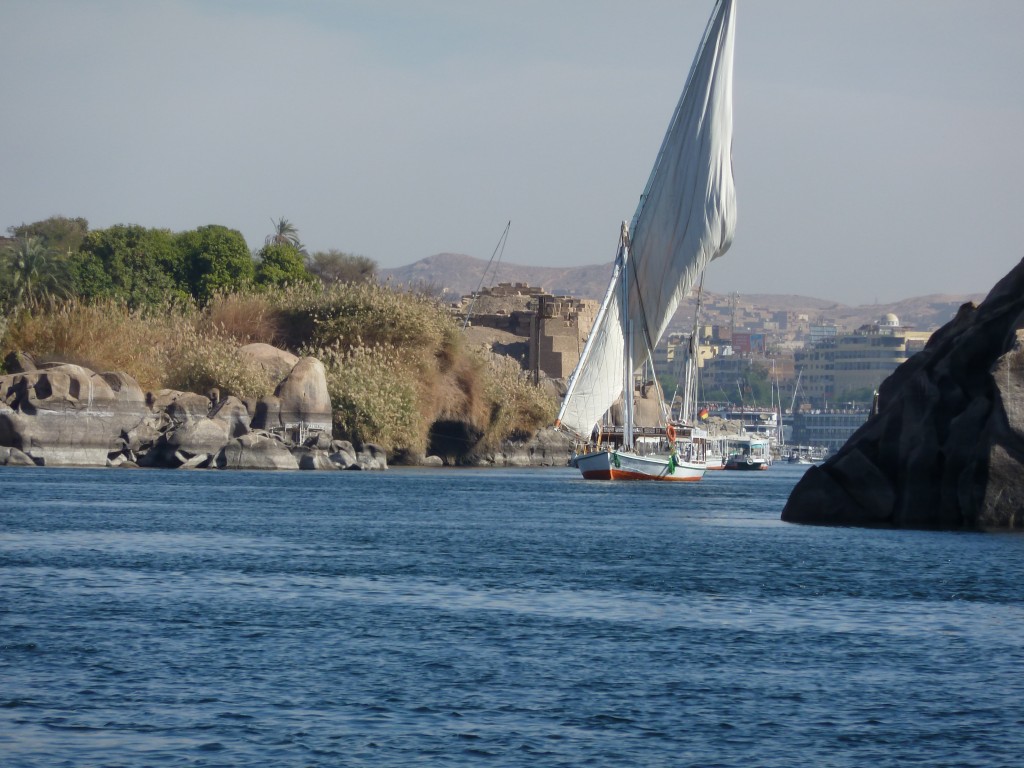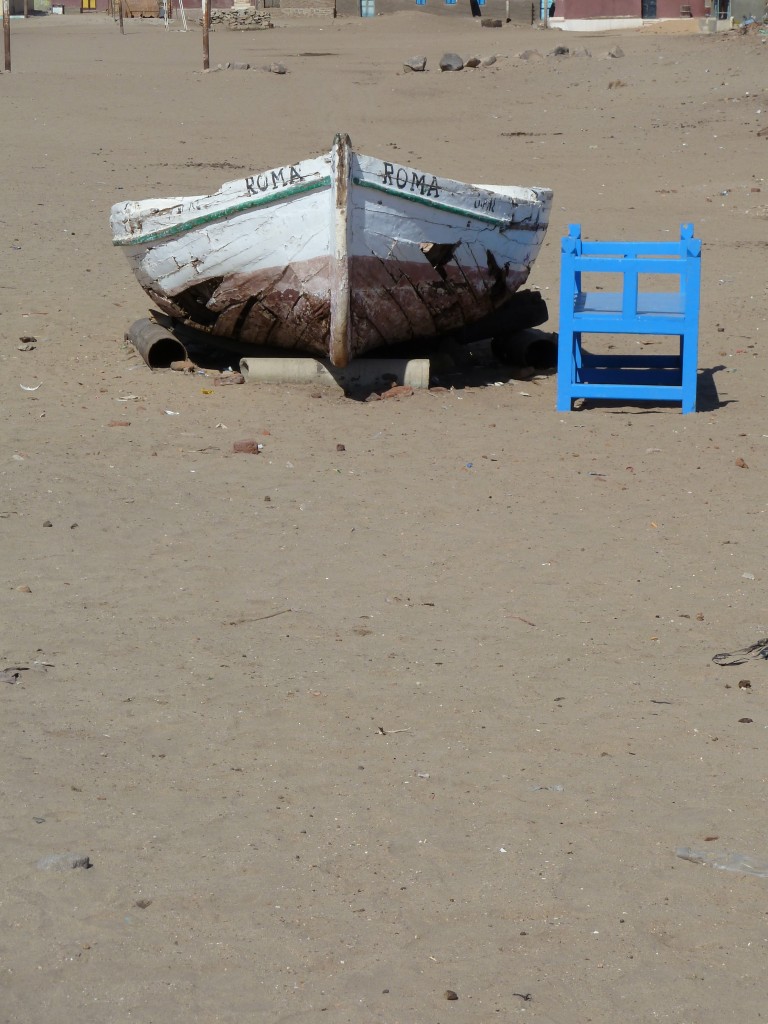Of things fake and things real
A felucca on the Nile is clearly a tourist experience, but there’s little that makes it touristy. The boats are basically hand built and generations old, you can see the adze marks on the masts and rudder. The sail is canvas and the ropes aren’t made from twisted reeds, but otherwise it’s hard to imagine that the boats have changed in many a generation. Sailing in the morning on the flat Nile gives a view that seems incredibly unchanging and calming. The sail hangs from a single tall boom and catches the prevailing winds, which luckily run counter to the flow of the Nile. You sail past beds of papyrus reeds;past the remnants of granite quarries, still marked with the pharaoh’s cartouche to show that rocks were legally quarried; and past turbaned locals rowing out in small canoes with a fishing net on the back. Huge grey herons swoop down to feed or sit on the rocks drying their wings and there is a silence broken only by the gentle splashing of the water against the hull and the creaking of the wooden boom.

Once we were well away from our starting point, the boat owner uncovered a range of quality artefacts that could be bought for very reasonable prices. The captive nature of the market was made clear when Declan failed to move the owner on price in the slightest. He ended up buying a knife made from Camel bone at a price that was a local rip-off but didn’t dent his Christmas money. The appearance of the trinkets occasioned a discussion with our guide who confirmed what we had suspected – that most of the stuff being sold in the markets and the tourist spots is actually made in China. Give the risible prices it’s possible to bargain people down to in the markets, we couldn’t see how they could possibly have been made in the same economy.
We transferred mid-stream from our felucca to another boat with an outboard and motored up-river to a Nubian village. The Nubians’ history is closely bound up with that of Egypt. At various times the Nubians conquered much of Egypt and vice versa and for much of early Egyptian history Nubia was the core of the trading route that brought gold, gems and spices from the rest of Africa into Egypt. Nubia had a proud and often rich history. Now Nubia is under the waters of Lake Nasser and the Nubians live a far different life. As the waters rose behind the Aswan Dam, the Nubians were resettled in villages closer to Aswan. As the Nile no longer floods traditional agriculture become impossible and most Nubians either moved to the cities or took up business with feluccas. The Nubians still maintain their own language and culture but inevitably it is fading in the face of overwhelming odds.
We visited a Nubian village about 30 minutes above Aswan. It is entirely authentic in the sense that people live their normal lives there – but part of their normal lives is welcoming tourists to their village. The visit was remarkably low-key for all that. Led by a lovely old man with missing teeth and a roguish smile, we wandered through their dusty streets to the local primary school. There we received a lesson in basic Arabic. Unfortunately the kids were on holidays so we just got to inspect and sit in their empty classrooms. Even that visit certainly put our complaints about facilities back home into some stark perspective. They suffer overcrowding in much the same way we do back home, but to such a degree that they run school in two shifts – you either go in the morning or in the afternoon. And as for resources, well basically they have none to speak of.
 School was followed by lunch in a Nubian home. We ate traditional food sitting on the floor of their guest room. The food had been cooked by the women of the family and providing a meal to tourists is clearly an important income stream for them. There was a mix of rice, vegetable stews, some sausage and potato chips. A bit of discussion with our guide revealed that the food was more traditional Egyptian than Nubian although the bread was Nubian. It was a tasty and wholesome meal and for all that it is a tourist experience it was a home-cooked meal in someone’s house in a small village and it felt real.
School was followed by lunch in a Nubian home. We ate traditional food sitting on the floor of their guest room. The food had been cooked by the women of the family and providing a meal to tourists is clearly an important income stream for them. There was a mix of rice, vegetable stews, some sausage and potato chips. A bit of discussion with our guide revealed that the food was more traditional Egyptian than Nubian although the bread was Nubian. It was a tasty and wholesome meal and for all that it is a tourist experience it was a home-cooked meal in someone’s house in a small village and it felt real.
We are tourists, there’s no escaping that fact. To any extent we might want to call ourselves’ travellers’ or anything less potentially pejorative than ‘tourist’ we certainly can’t make any claims while on an actual tour. But there’s nothing wrong with being a tourist – we’re always going to see major sights, we’re going to do things the locals wouldn’t and, especially in somewhere like Egypt, it’s largely trite to pretend that we’re anything other than privileged visitors. That said it’s nice to maintain the mystique. Walking through the dust, riding on the felucca and a meal in a local home – they’re real experiences. Buying mass-produced junk of China instead of mass-produced Egyptian junk, well that’s just not real.
And really real? That was the fisherman we met by chance at the end. He showed us the puffer-fish he’d just caught. He explained how he annoys it until it puffs up to full size an then stuffs it full of sand through its anus. In a couple of weeks it dries out and he removes the sand leaving the spherical shape intact. It makes, he told us, a wonderful lampshade.
1 thought on “Of things fake and things real”